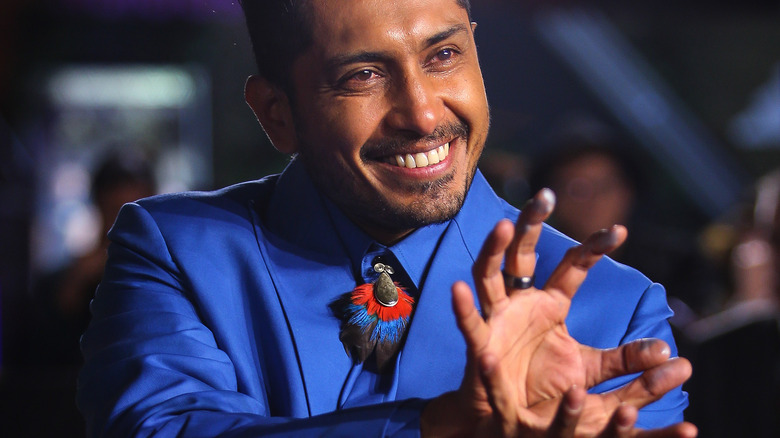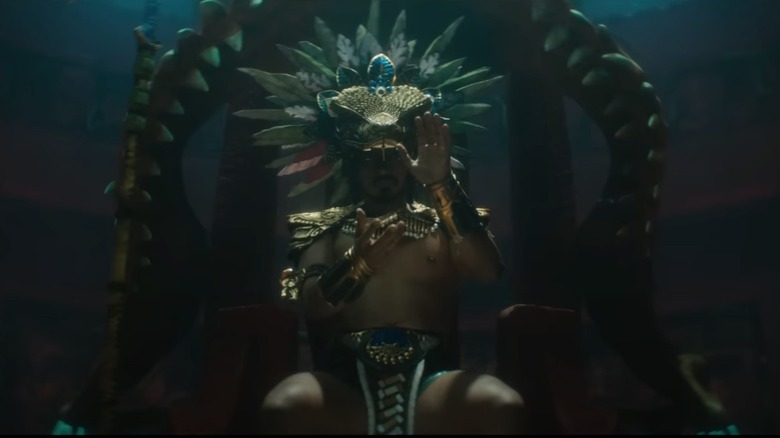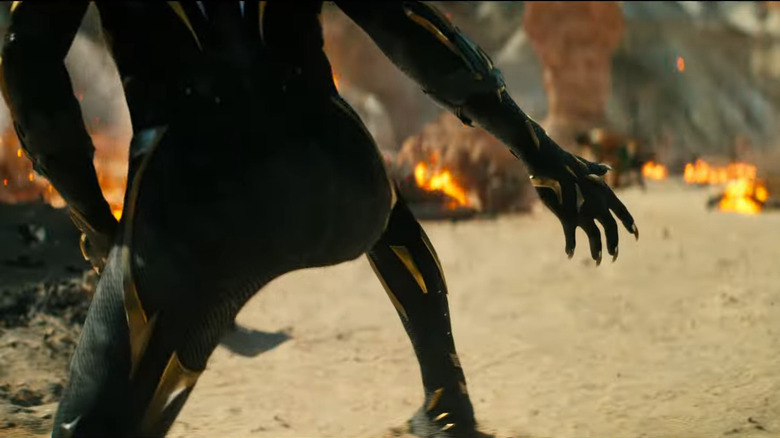The Inspiration Behind The Talokan Salute In Black Panther: Wakanda Forever
The follow up to 2018's "Black Panther" was always going to face unfair comparisons to other films. Not only did it need to live up to its predecessor, but "Black Panther: Wakanda Forever" is also arriving at a time when its set pieces look strangely like James Cameron's forthcoming "Avatar" sequel and its rendering of a fictional underwater city follows in the footsteps of James Wan's nothing-if-not visually spectacular "Aquaman." Where "Wakanda Forever" surely succeeds though is in its use of Mayan and Aztec history to reinterpret Marvel Comics' Namor: The Sub-Mariner for a modern audience and to update the tired trope of Atlantis with the fresh image of Talokan.
We would expect nothing less from writer-director Ryan Coogler, whose wide inclusion of cultures across Africa in the first cinematic imagining of Wakanda (however reductive) was a large part of what made "Black Panther" a hit. And like Wakanda, one of the defining elements of Talokan's depiction is the salute that Namor and his people make to one another. While what we see in the film has a strong historical basis, it was also the product of some creative thinking by the cast and crew.
¡Líik'ik Talokan!
On multiple occasions, the 500-year old mutant king Namor makes a distinct gesture, taking the form of a sea monster's jaws with his hands open and bent towards each other. His people respond in kind and shout, "¡Líik'ik Talokan!" It turns out Namor's hand gesture is not a reference to the Egyptian god Ammit, who is the villain of Marvel's "Moon Knight," nor does it have anything to do with Talokan being a sea-faring society. Instead, it is inspired by an Aztec manuscript called the Codex Zouche-Nuttall, which dates back roughly to the 14th century.
The ancient graphic novel portrays an Aztec ruler named Eight Deer Jaguar-Claw who (much like Namor) rises from the lower class to the crown. In one panel, Eight Deer consults his godly ancestor for wisdom and opens his hands to him in a similar fashion to the Talokan salute. This gesticulation appears again in other places on the codex, which must have caught the attention of cultural historians involved in "Wakanda Forever."
But it was the Latino cast that completed the vision for the Wakanda Forever counterpart by creating a chant to go with the gesture. In an interview with Cinema Blend, Venezuelan actor Alex Livinalli, who plays Namor's muscle, Attuma, explained the origin of the Talokan battle cry:
"You caught that! That was not part of the original script ... it was a consensus thing, we were like ... the Black Panther, they have 'Wakanda Forever,' and it's so powerful and means so much. And we're very similar to the Wakandans ... So after conversations with a language instructor, we came up with, 'Talokan rises,' which is 1, 2, 3, '¡Líik'ik Talokan!' which is like 'yeah, we're here. This is our mantra, so to speak.'"
Double-edged sword
It may not be possible for "Wakanda Forever" to overcome the same affliction as both its source material and many other films — whether the first "Black Panther" or 1992's "Aladdin" — in delivering long-overdue representation of racial groups without the compromise of combining aspects of several cultures and traditions. In this case, Talokan, or Tlālōcān in the Aztec's original Nahuatl language, is purely an artifact of Aztec mythology, while the Talokanil speak Yucatán Mayan and refer to Namor as the Mayans' flying Feathered Serpent god, K'uk'ulkan. Audiences of every background will decide for themselves if the output here is more melting pot or Frankenstein's monster, but the Talokan salute is at least one example of an earnest attempt at authenticity when laziness might have passed for many viewers.
At least at SlashFilm, our writers have argued that "Wakanda Forever" made a positive contribution to Latin and Hispanic representation and that the film's alterations to Namor's comic book origins have been for the better.


